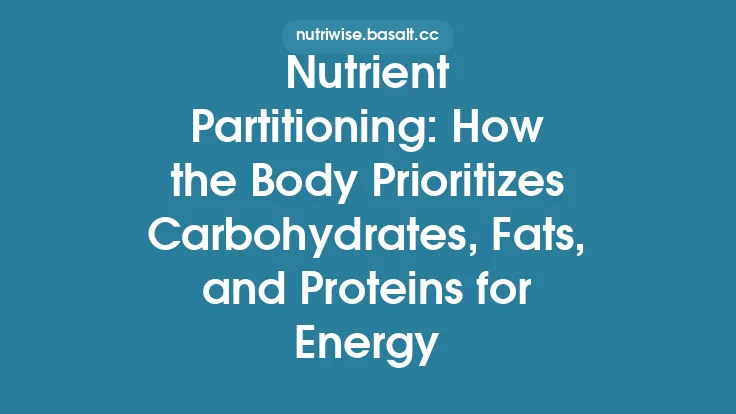Morning, Midday, and Evening: Optimizing Nutrient Timing for Energy Balance
The human body is a dynamic engine that constantly shifts between fuel sources, adjusts its metabolic rate, and responds to internal clocks. While total daily calories ultimately dictate weight change, *when* those calories are delivered can influence how efficiently the body utilizes them, how much energy is expended in processing them, and how well the day‑to‑day energy budget aligns with activity patterns. This article explores the science behind aligning macronutrient delivery with the body’s circadian and metabolic rhythms to support a stable energy balance, without delving into exercise‑specific recovery, sleep‑focused strategies, or the classic “protein‑for‑muscle” and “carb‑for‑blood‑sugar” narratives.
Circadian Rhythms and Metabolic Pathways
The 24‑hour circadian system orchestrates hormone secretion, enzyme activity, and substrate preference. Key points relevant to nutrient timing include:
| Time of Day | Dominant Hormonal Milieu | Primary Metabolic Preference |
|---|---|---|
| Early Morning (≈06:00‑09:00) | ↑ Cortisol, ↑ Growth Hormone, ↓ Insulin Sensitivity | ↑ Lipolysis, ↑ Fat Oxidation |
| Mid‑Day (≈11:00‑15:00) | Peak Insulin Sensitivity, Moderate Cortisol | ↑ Glucose Utilization, ↑ Carbohydrate Oxidation |
| Late Evening (≈18:00‑22:00) | ↓ Insulin Sensitivity, ↑ Melatonin | ↑ Lipid Storage, ↓ Thermogenesis |
- Cortisol spikes upon waking, mobilizing free fatty acids (FFAs) to meet the brain’s immediate energy demand before food intake.
- Insulin sensitivity follows a sinusoidal pattern, reaching its apex around midday, which facilitates rapid glucose uptake and storage.
- Melatonin rises after dusk, signaling a shift toward energy conservation and favoring lipid storage pathways.
These rhythmic fluctuations affect the thermic effect of food (TEF)—the energy cost of digestion, absorption, and storage. TEF is modestly higher when insulin sensitivity is greatest (mid‑day) and lower when the body is primed for storage (evening). Understanding these patterns allows us to align macronutrient delivery with the body’s natural propensity for either oxidation or storage.
Morning Nutrient Strategies for Energy Initiation
1. Leverage the Lipolytic State
Because cortisol‑driven lipolysis is high upon waking, the body is primed to oxidize fats. A modest inclusion of medium‑chain triglycerides (MCTs) or omega‑3 rich oils can:
- Provide a rapid, oxidation‑favored fuel that bypasses the need for bile‑mediated emulsification.
- Support mitochondrial efficiency, enhancing the capacity for subsequent carbohydrate oxidation later in the day.
2. Moderate Carbohydrate Load
While the morning is not the peak window for glucose uptake, a controlled carbohydrate portion (≈15‑20 % of total daily calories) can:
- Replenish hepatic glycogen depleted overnight, preventing excessive gluconeogenesis.
- Avoid overwhelming the relatively lower insulin sensitivity, which could otherwise promote early storage.
3. Prioritize High‑Quality Protein for Thermogenesis
Protein’s TEF is the highest among macronutrients (≈20‑30 % of its caloric value). Consuming a protein dose of 0.2‑0.3 g kg⁻¹ in the first meal:
- Elevates post‑prandial energy expenditure.
- Supplies essential amino acids for tissue turnover without focusing on muscle hypertrophy.
Midday Nutrient Strategies for Sustained Output
1. Capitalize on Peak Insulin Sensitivity
Mid‑day is the metabolic “sweet spot” for carbohydrate oxidation. A larger carbohydrate fraction (≈30‑35 % of daily calories) can be strategically placed in the lunch window to:
- Maximize glucose uptake into skeletal muscle and adipose tissue for immediate use.
- Reduce the need for post‑prandial hyperinsulinemia later, which can blunt subsequent fat oxidation.
2. Balance with Moderate Fat
Including monounsaturated fats (e.g., olive oil, avocado) at this time supports:
- Satiety without heavily suppressing insulin’s action.
- A smoother transition to the evening’s storage‑oriented metabolism.
3. Protein for Metabolic Flexibility
A mid‑day protein dose of 0.25‑0.35 g kg⁻¹ continues to drive TEF while also providing substrates for gluconeogenesis if glucose availability dips. This helps maintain a metabolic flexibility—the ability to switch between carbs and fats without large swings in blood metabolites.
Evening Nutrient Strategies for Energy Conservation and Recovery
1. Shift Toward Lipid‑Dominant Intake
As insulin sensitivity wanes, the body naturally favors lipid storage. An evening macronutrient profile that leans toward 45‑50 % of daily calories from fats aligns with this physiological state, allowing:
- Efficient incorporation of dietary fatty acids into adipose tissue with minimal energetic cost.
- Preservation of glycogen stores for the next day’s morning activity.
2. Reduce Carbohydrate Load
Limiting evening carbohydrates to ≤10‑15 % of total daily calories prevents:
- Excessive post‑prandial insulin spikes that could promote unwanted lipid synthesis (de novo lipogenesis).
- Potential interference with the natural decline in metabolic rate that occurs during the night.
3. Protein for Maintenance, Not Anabolism
A smaller protein portion (≈0.15‑0.2 g kg⁻¹) in the final meal supplies essential amino acids for overnight tissue repair while keeping TEF modest, which is desirable when the body is transitioning to a lower metabolic state.
Integrating Macro Timing with Daily Energy Expenditure
| Phase | Primary Energy Expenditure Component | Macro Emphasis | Expected Impact on Energy Balance |
|---|---|---|---|
| Morning | Basal Metabolic Rate (BMR) + NEAT (post‑wake activity) | Fats + moderate protein | ↑ TEF, ↑ fat oxidation, minimal storage |
| Midday | Physical activity (work, errands) + Thermic effect of larger meals | Carbs + moderate protein + moderate fats | ↑ glucose utilization, peak TEF, balanced storage |
| Evening | BMR + reduced NEAT (wind‑down) | Fats + low carbs + lower protein | ↓ TEF, favor storage, prepare glycogen for next day |
By matching macro composition to the dominant energy‑expenditure component of each period, the net energy balance (calories in vs. calories out) can be fine‑tuned without altering total intake. This approach is especially useful for individuals who:
- Experience plateaus despite caloric adherence.
- Have variable daily activity levels (e.g., sedentary mornings, active afternoons).
- Seek to optimize body composition while maintaining performance in non‑exercise contexts.
Special Populations and Chronotype Considerations
1. Early vs. Late Chronotypes
- Morning types (larks) naturally exhibit an earlier cortisol peak and may benefit from a slightly larger fat‑rich breakfast to harness early lipolysis.
- Evening types (owls) often have delayed insulin sensitivity peaks; they might shift a modest carbohydrate portion later into the early afternoon to align with their metabolic window.
2. Shift Workers
For those on rotating schedules, the external light‑dark cycle can be misaligned with internal hormonal rhythms. Strategies include:
- Timed light exposure to reset circadian cues.
- Meal timing that mimics the described pattern relative to the individual’s “biological day,” even if that day falls during night‑time work hours.
3. Metabolic Disorders
Individuals with impaired glucose tolerance may benefit from a more pronounced carbohydrate restriction in the evening to avoid prolonged hyperinsulinemia. Conversely, those with hypothyroidism (often associated with reduced basal metabolic rate) might increase mid‑day protein and carbohydrate to boost TEF during the period of highest insulin sensitivity.
Practical Implementation and Common Pitfalls
- Plan Meals Around Activity Peaks – Align larger carbohydrate portions with the time you anticipate the most movement (e.g., work tasks, errands).
- Use Food Timing Apps – Track not just calories but also the clock time of each macro intake to identify patterns.
- Avoid “All‑Or‑Nothing” Shifts – Gradual adjustments (e.g., 5‑10 % macro changes per week) prevent metabolic shock and improve adherence.
- Watch for Hidden Carbs at Night – Sauces, dressings, and “healthy” snacks can unintentionally raise evening carbohydrate load.
- Stay Hydrated – Adequate water supports lipolysis in the morning and aids nutrient transport throughout the day.
- Monitor Subjective Energy Levels – Fatigue, cravings, or mood swings can signal a misalignment between macro timing and personal circadian rhythm.
Bottom Line
Optimizing nutrient timing for energy balance is less about “what” you eat and more about when you deliver each macronutrient relative to the body’s intrinsic metabolic cycles. By:
- Leveraging the morning’s lipolytic environment with modest fats and protein,
- Harnessing midday insulin sensitivity with a carbohydrate‑focused meal, and
- Embracing the evening’s storage‑oriented state with a higher fat proportion,
you can subtly shift the proportion of calories that are oxidized versus stored, thereby fine‑tuning the daily energy equation without changing total intake. This chronobiology‑informed approach offers a practical, evidence‑based pathway for anyone seeking to maintain a stable energy balance, improve metabolic flexibility, and support long‑term body composition goals.





